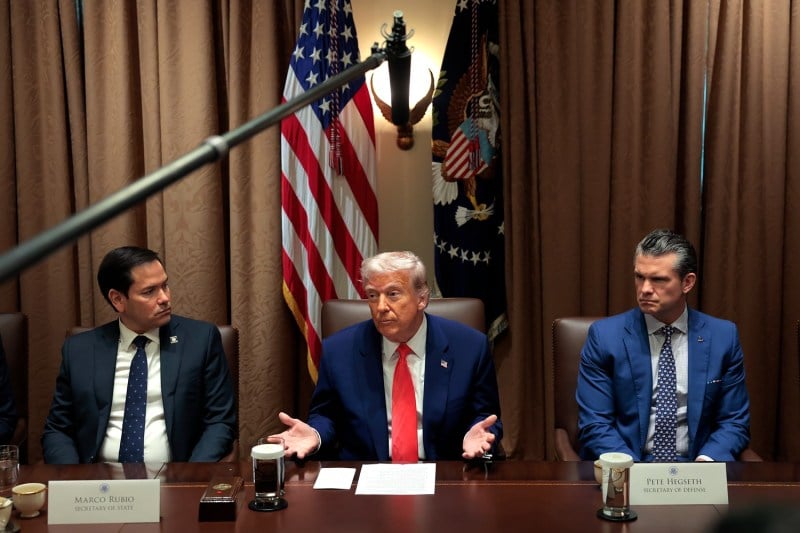Businesses on Both Sides of the Pacific Brace for Impact

Businesses on Both Sides of the Pacific Brace for Impact
In China and the United States, trade war uncertainty is prompting difficult decisions.
An employee works at a toy factory specializing in solar-powered plastic gadgets in Yiwu, in China’s eastern Zhejiang province, on April 11. Adek Berry/AFP via Getty Images
Welcome to Foreign Policy’s China Brief.
The highlights this week: The U.S.-China trade war creates uncertainty for businesses, Chinese mercenaries are fighting for Russia in Ukraine, and Chinese President Xi Jinping travels to Vietnam.
Welcome to Foreign Policy’s China Brief.
The highlights this week: The U.S.-China trade war creates uncertainty for businesses, Chinese mercenaries are fighting for Russia in Ukraine, and Chinese President Xi Jinping travels to Vietnam.
Trade War Looms Over Businesses
At a time when U.S.-China trade relations can turn on a dime, it’s easy to forget that the cargo being traded moves slowly.
It takes about two and a half weeks for a ship leaving Shanghai to cross the Pacific Ocean. This means that the vessels that left on April 2, when U.S. President Donald Trump initially announced so-called reciprocal tariffs, will still be in transit for another week.
When those ships departed China, the expected U.S. tariff for most cargo was around 20 percent. When they dock, their cargo could theoretically face an effective rate of 145 percent or an even higher rate—or Trump could have backed down from this trade war altogether. Trump’s team is sending mixed signals on whether the tariffs will exclude key goods such as smartphones.
The United States has issued a grace period for tariffs on cargo loaded before April 5 that extends through May 27, so the full impact on supply chains and U.S. prices likely won’t be visible for another few weeks.
But this confusion and uncertainty mean that financial markets are still underpricing what is essentially a full decoupling of the world’s two largest economies. For its part, China is hitting back with measures including a rare-earth squeeze and curbs on Hollywood, with potentially much more to come.
Meanwhile, businesses have had to make difficult decisions about whether it’s worth loading ships in China. Giants such as Amazon and Apple will fare better than most, in part because they stockpiled product prior to the onset of the trade war. Because of their size, they also have the capacity to absorb losses and to cut deals directly with Trump.
But for U.S. small businesses that manufacture in China, the effective loss of a single shipment can mean bankruptcy. And for most of these businesses, sourcing elsewhere isn’t an option.
The sourcing issue highlights another time lag made visible by these tariff wars: Trump’s worldview was shaped in the 1980s, when China’s low labor costs made it an attractive choice for cheap manufacturing. At that time, a change in costs could have forced manufacturing back to the United States.
But the advantage of Chinese manufacturing today is not just labor costs—which are now higher than those in countries such as Vietnam or Bangladesh—but also decades of built-up infrastructure, personnel, and expertise. None of that can be replaced in the United States within a year, let alone a month.
Manufacturing involves two types of knowledge—what anthropologist James C. Scott famously characterized as techne and metis. Techne is scientific, abstract knowledge: patents, blueprints, advanced technology.
Yet production also runs on metis: the everyday knowledge of how things work and of skills that are difficult to perceive from higher up. That can include the quirks of a particular machine, delicate handwork that can’t be automated, and software debugging techniques. Metis is often passed down informally; line supervisors and factory workers can learn from more experienced staff.
The United States has no shortage of techne, though there are now several fields in which China is clearly ahead, such as electric vehicles and batteries. But after decades of focusing on higher-end services rather than manufacturing, the United States lacks the necessary metis to keep up with China.
In this sense, a U.S. manufacturing revival would be effectively starting from scratch for many industries. Though the United States could develop its own knowledge over time, that would take many years and many mistakes, as it did for China.
Take board games manufacturing—a $14 billion industry comprising many small companies and one that is now in full panic mode. As Meredith Placko, the CEO of long-running firm Steve Jackson Games, wrote in a useful post: “The infrastructure to support full-scale boardgame production—specialty dice making, die-cutting, custom plastic and wood components—doesn’t meaningfully exist [in the United States] yet.”
“This isn’t about steel and semiconductors. This is about paper goods, chipboard, wood tokens, plastic trays, and color-matched ink,” Placko wrote.
The pain to small businesses will hit both sides of the Pacific. Smaller Chinese manufacturers will be badly affected, and the country’s economy is bound to take a hit. But after years of dealing with U.S. threats, manufacturers and exporters have grown their own expertise and diversified markets in a way that U.S. firms have largely not managed to do with suppliers.
What We’re Following
Updates on military purges. The Financial Times reported that several sources have confirmed rumors that a top Chinese general who has been missing from public view for a few months, He Weidong, is under investigation. If true, this would mark a significant escalation in China’s latest round of military purges.
He is one of the first top military figures to fall in recent years who doesn’t have ties to the People’s Liberation Army (PLA) Rocket Force, which seems to have been the nexus of a major corruption scandal. Chinese military corruption goes far beyond the Rocket Force, but He was also a loyalist to Chinese President Xi Jinping, affording him a certain expected leeway.
It’s possible that He was stealing on a scale that threatened military readiness, but China’s trade conflict with the United States could also be heightening tensions. It has been more than a decade since the mass killing of CIA assets in China; that is enough time for a new espionage network to spring up—or for Beijing to be convinced that there is one.
Chinese mercenaries in Ukraine. Ukrainian President Volodymyr Zelensky has confirmed that some 150 Chinese nationals are fighting for Russia in Ukraine, but they seem to be mercenaries, not PLA soldiers. Russia has put out recruitment videos across Chinese social media as its need for military manpower grows.
Cindy Carter, the deputy editor at China Digital Times, translated a fascinating interview with one mercenary, in which he laments that Chinese nationalistic movies gave him a false view of what war was like.
“A lot of people watch these exaggerated patriotic dramas that glorify war—like ‘Wolf Warrior’ and ‘Drawing Sword’—and they get all fired up. But the reality of battle is incredibly brutal. It’s literally hell on earth,” he said.
FP’s Most Read This Week
- How to Ruin a Country by Stephen M. Walt
- Why Beijing Thinks It Can Beat Trump by Scott Kennedy
- Why Don’t Russian Soldiers Revolt? by Amelie Tolvin
Tech and Business
Xi visits Vietnam. This week, Xi is making the case for free trade as he tours Southeast Asia. Trump has criticized the trip, saying it is intended to plot how to “screw” the United States, but Xi’s travels were arranged before the trade war began. Xi has used his tour as an opportunity for Beijing to sell itself as a bulwark of “stability and certainty,” in contrast to Washington.
On Monday, Xi arrived in Vietnam—a key swing state in the region. Vietnam today balances security ties with the United States and economic ties with China, despite being ideologically communist.
That balancing act is now in full view: Vietnam signed dozens of cooperation deals during Xi’s visit but has also promised tighter controls on Chinese goods after Trump threatened 46 percent tariffs on Vietnam, which are currently paused.
Vietnam was a popular destination for transshipment of Chinese goods to avoid tariffs during Trump’s first term, but the shotgun approach to imposing global tariffs makes that less likely this time around.
Made in China 2025. This is the year of delivery for the grand technological project that China outlined in 2015, at the time prompting consternation in Washington that Beijing was looking to technologically and economically overtake the United States.
The current scorecard, as drawn up by the Wire China, shows that many aspects of the plan have succeeded. There were serious failings in some areas—notably semiconductor manufacturing, where the combination of corruption and U.S. sanctions has kept China short of its targets.
However, in other areas, such as EVs, China has succeeded beyond its political leadership’s wildest dreams.
James Palmer is a deputy editor at Foreign Policy. X: @BeijingPalmer
More from Foreign Policy
-

U.S. President Donald Trump gives a thumbs-up upon arrival at Joint Base Andrews in Maryland after spending the weekend at Mar-a-Lago. How to Ruin a Country
A step-by-step guide to Donald Trump’s destruction of U.S. foreign policy.
-

Chinese President Xi Jinping arrives for a meeting with Vietnamese National Assembly Chairman Tran Thanh Man in Hanoi on April 14. Why Beijing Is Standing Up to Trump
Chinese leaders have their pride, too.
-

Russian soldiers practice marching Why Don’t Russian Soldiers Revolt?
Astonishing death rates and brutal abuse have not kept troops from following orders.
-

An illustration shows a police officer trying to sudue a panicked mob of men. The Awful History of Tariffs and Depressions
What the 19th century teaches us about what happens next.








Join the Conversation
Commenting on this and other recent articles is just one benefit of a Foreign Policy subscription.
Already a subscriber?
.
Subscribe
Subscribe
View Comments
Join the Conversation
Join the conversation on this and other recent Foreign Policy articles when you subscribe now.
Subscribe
Subscribe
Not your account?
View Comments
Join the Conversation
Please follow our comment guidelines, stay on topic, and be civil, courteous, and respectful of others’ beliefs.
Change your username |
Log out
Change your username:
CANCEL
Confirm your username to get started.
The default username below has been generated using the first name and last initial on your FP subscriber account. Usernames may be updated at any time and must not contain inappropriate or offensive language.